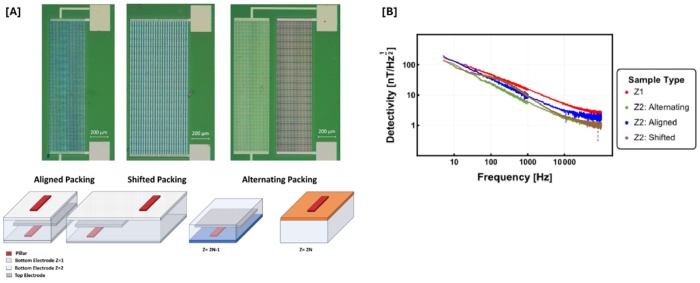Speaker
Description
3D Packing emerges as a novel method to push the detectivity of TMR sensors to state-of-the-art pT detectivities by vertically connecting TMR sensors in parallel. Diverging from conventional sensor design strategies that rely on creating 2D arrays, this innovative approach preserves a compact footprint crucial for high spatial resolution where xMR technologies excel [1].
In this work, we demonstrate a decrease in detectivity with the number of vertical iterations, due to the $1/\sqrt{Z}$ dependency as expressed in equation 1, obtained from the TMR sensor's sensitivity through magneto-electrical measurements and its noise spectra, following the models described by [2].
$D= \frac{dH}{dri}\sqrt{\left(4k_{b}Tr+ \frac{\alpha'_{H}r^{2}i^{2}}{f} \right)\frac{1}{XYZ}} \quad (1)$
Due to an increase in surface roughness and topography, which occurs upon overlapping several layers of patterned films during the microfabrication steps, different packing strategies are implemented to reduce it: shifted and alternating packing (Fig. 1a). These strategies try to minimize topography in the areas of the MTJ pillars and consist of different alignments between bottom electrodes and pillar structures, thus leading to different detectivity results. Here we describe the process challenges for the vertical integration of the devices, and their impact on the sensor sensitivity and overall detectivity.
Comparing with a single TMR, two levels packed TMR sensors show lower detectivity across the measured spectra, between 5 and 100 kHz (Fig. 1b). Additionally, the topography control strategies lead to a lower detectivity overall, obtaining a detectivity of 102 nT.Hz$^{1/2}$ and 90 nT.Hz$^{1/2}$ at 10 Hz for the alternating and shifted strategies.

Fig. 1 a) Schematic of the different packing strategies: aligned, shifted, and alternating strategies. b) Corresponding detectivity spectra between 5 and 100kHz for Z=1 and Z=2.
Acknowledgements
The authors acknowledge BASE (UIDB/0536/2020), PROGRAMATICO (UIDP/0536/2020) Programs.
References
[1] M. Silva, F. Franco, D. C. Leitao, S. Cardoso, and P. P. Freitas, “Two-dimensional arrays of vertically packed spin-valves with picoTesla sensitivity at room temperature,” Scientific Reports, vol. 11, no. 1. Springer Science and Business Media LLC, Jan. 08, 2021. doi: 10.1038/s41598-020-79856-0.
[2] Z. Q. Lei, G. J. Li, W. F. Egelhoff, P. T. Lai, and P. W. T. Pong, “Review of Noise Sources in Magnetic Tunnel Junction Sensors,” IEEE Transactions on Magnetics, vol. 47, no. 3. Institute of Electrical and Electronics Engineers (IEEE), pp. 602–612, Mar. 2011. doi: 10.1109/tmag.2010.2100814.

